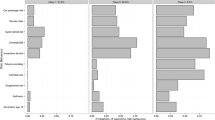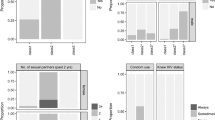Abstract
We demonstrate the utility of cluster analysis for identifying diverse HIV risk groups found in a community-based sample. Within a group of 706 American Indian young adults, we used cluster analysis to identify four profiles of HIV risk/protection. The High Efficacy/Low Risk cluster had high levels of knowledge/education, self-efficacy, and outcome expectations about HIV protection, with low levels of risk behaviors. Low Efficacy/Low Risk had low levels of HIV knowledge/education, self-efficacy, and outcome expectations, but high levels of perceived risk for HIV with low levels of HIV risk behaviors. Low Efficacy/Moderate Risk was similar to the previous group, but its members had moderately higher levels of several risk behaviors and higher condom use. Low Efficacy/High Risk had high rates of several high-risk behaviors such as exchanging sex for money or injection drug use. Validation analyses highlighted differences that can be useful for the development of preventive interventions.
Similar content being viewed by others
REFERENCES
Aldenderfer, M. S., and Blashfield, R. K. (1984). Cluster analysis. Beverly Hills, CA: Sage.
Allen, J. P., Weissberg, R. P., and Hawkins, J. (1989). The relationship between values and social competence in early adolescence. Developmental Psychology, 25, 458–464.
Allison, P. D. (2002). Missing data. Thousand Oaks, CA: Sage.
Arnold, P., Fletcher, S., and Farrow, R. (2002). Condom use and psychological sensation seeking by college students. Sexual and Relationship Therapy, 17, 355–366.
Bandura, A. (1986). Social foundations of thought and action: A social cognitive theory. Englewood Cliffs, NJ: Prentice-Hall.
Bandura, A. (1990). Perceived self-efficacy in the exercise of control over AIDS infection. Evaluation and Program Planning, 13, 9–17.
Bandura, A. (1994). Social cognitive theory and exercise of control over HIV infection. In R. J. DiClemente and J. L. Peterson (Eds.), Preventing AIDS: Theories and methods of behavioral interventions (pp. 25–59). New York: Plenum.
Bandura, A. (1997). Self-efficacy: The exercise of control. New York: Freeman.
Bartholomew, L. K., Parcel, G. S., Kok, G., and Gottlieb, N. H. (2001). Intervention mapping: Designing theory-and evidence-based health promotion programs. Mountain View, CA: Mayfield Publishing.
Basen-Engquist, K., Coyle, K. K., Parcel, G. S., Kirby, D., Banspach, S. W., Carvajal, S. C., and Baumler, E. (2001). Schoolwide effects of a multicomponent HIV, STD, and pregnancy prevention program for high school students. Health Education and Behavio, 28, 166–185.
Brassard, P., Smeja, C., and Valverde, C. (1996). Needs assessment for an urban native HIV and AIDS prevention program. AIDS Education and Prevention, 8(4), 343–351.
Cabral, R. J., Galvotti, C., Armstrong, K., Morrow, B., and Fogarty, L. (2001). Reproductive and contraceptive attitudes as predictors of condom use among women in an HIV prevention intervention. Women and Health, 33, 117–132.
Carey, M. P., Carey, K. B., and Kalichman, S. C. (1997). Risk for Human Immunodeficiency Virus (HIV) infection among persons with severe mental illnesses. Clinical Psychology Review, 17, 271–291.
Centers for Disease Control and Prevention. (2000). Sexually Transmitted Disease Surveillance 1999. Atlanta: Centers for Disease Control and Prevention.
Centers for Disease Control and Prevention. (2002). HIV Surveil-lance Report. Atlanta: Department of Health and Human Services.
Cerwonka, E. R., Isbell, T. R., and Hansen, C. E. (2000). Psychosocial factors as predictors of unsafe sexual practices among young adults. AIDS Education and Prevention, 12, 141–153.
Combs, D. R., and Livingston, R. B. (2001). Psychological sub-types among persons with HIV infection: An empirical study. AIDS Care, 13, 157–162.
Dennis, M. L., Wechsberg, W. M., McDermeit, M., Campbell, R. S., and Rasch, R. R. (2001). The correlates and predictive validity of HIV risk groups among drug users in a community-based sample: Methodological findings from a multi-site cluster analysis. Evaluation and Program Planning, 24, 187–206.
Devieux, J. G., Malow, R. M., Stein, J. A., Jennings, T. E., Lucenko, B. A., Averhart, C., and Kalichman, S. (2002). Impulsivity and HIV risk among adjudicated alcohol-and other drug-abusing adolescent offenders. AIDS Education and Prevention, 14(Suppl. B), 24–35.
Donohew, L., Zimmerman, R., Cupp, P. S., Novak, S., Colon, S., and Abell, R. (2000). Sensation seeking, impulsive decision-making, and risky sex: Implications for risk-taking and design of interventions. Personality and Individual Differences, 28, 1079–1091.
Eng, T. R., and Butler, W. T. (1997). The hidden epidemic: Confronting sexually transmitted diseases. Washington, DC: National Academy Press.
Everitt, B. S., Landau, S., and Leese, M. (2001). Cluster analysis (4th ed.). New York: Oxford University Press.
Fisher, J. D., Fisher, W. A., Bryan, A. D., and Misovich, S. J. (2002). Information-motivation-behavioral skills model-based HIV risk behavior change intervention for inner-city high school youth. Health Psychology, 21, 177–186.
Graham, J. W., Taylor, B. J., and Cumsille, P. E. (2001). Planned missing-data designs in analysis of change. In L. M. Collins and A. G. Sayer (Eds.), New methods for the analysis of change (pp. 335–353). Washington, DC: American Psychological Association.
Hobfoll, S., Jackson, A. P., Lavin, J., Johnson, R. J., and Schroeder, K. E. E. (2002). Effects of generalizability of communally oriented HIV-AIDS prevention versus general health promotion groups for single inner-city in urban clinics. Journal of Consulting and Clinical Psychology, 70, 950–960.
Hovell, M. F., Blumberg, E. J., Powell, L., Morrison, T. C., Duran, G., Sipan, C.L., et al. (2001). Training AIDS and anger prevention social skills in at-risk adolescents. Journal of Counseling and Development, 79, 347–355.
Jackson, D. N. (1974). Personality Research Form manual. Goshen, NY: Research Psychologists Press.
Jemmott, J. B., Jemmott, L. S., Spears, H., Hewitt, N., and Cruz-Collins, M. (1992). Self-efficacy, hedonistic expectancies, and condom-use intentions among inner-city Black adolescent women: A social cognitive approach to AIDS risk behavior. Journal of Adolescent Health, 13, 512–519.
Kennedy, M. G., Mizuno, Y., Hoffman, R., Baume, C., and Strand, J. (2000). The effect of tailoring a model HIV prevention program for local adolescent target audiences. AIDS Education and Prevention, 12, 225–238.
Langer, L. M., Tubman, J. G., and Duncan, S. (1998). Anticipated mortality, HIV vulnerability, and psychological distress among adolescents and young adults at higher and lower risk for HIV infection. Journal of Youth and Adolescence, 27, 513–538.
Liau, A., DiClemente, R. J., Wingood, G. M., Crosby, R. A., Williams, K. M., Harrington, K., et al. (2002). Associations between biologically confirmed marijuana use and laboratory-confirmed sexually transmitted diseases among African American adolescent females. Sexually Transmitted Diseases, 7, 387–390.
Long, J. S., and Freese, J. (2001). Regression models for categorical dependent variables using Stata. College Station, TX: Stata Corporation.
Lorr, M. (1983). Cluster analysis for social scientists. Washington, DC: Jossey-Bass.
Malotte, C. K., Jarvis, B., Fishbein, M., Kamb, M., Iatesta, M., Hoxworth, T., et al. (2000). Stage of change versus an integrated psychosocial theory as a basis for developing effective behaviour change interventions. AIDS Care, 12, 357–364.
McMahon, R. C., Malow, R. M., and Penedo, F. J. (1998). Substance abuse problems, psychiatric severity, and HIV risk in Millon clinical Multiaxial Inventory—II personality sub-groups. Psychology of Addictive Behavior, 12, 3–13.
Mitchell, C. M., Kaufman, C. E., and the Pathways of Choice and Healthy Ways Project Teams. (2002). Structure of HIV knowledge, attitudes, and behaviors among American Indian young adults. AIDS Education and Prevention, 14, 381–398.
Mitchell, C. M., O'Nell, T. D., Beals, J., Dick, R. W., Keane, E., and Manson, S. M. (1996). Dimensionality of alcohol use among American Indian adolescents: Latent structure, construct validity, and implications for developmental research. Journal of Research on Adolescence, 6, 151–180.
Muñoz, R. F., Mrazek, P. J., and Haggerty, R. J. (1996). Institute of Medicine report on prevention of mental disorders: Summary and commentary. American Psychologist, 51, 1116–1122.
Nangle, D. W., and Hansen, D. J. (1998). Adolescent heterosocial competence revisited: Implications of an extended conceptualization for the prevention of high-risk sexual interactions. Education and Treatment of Children, 21, 431–446.
Newman, P. A., and Zimmerman, M. A. (2000). Gender differences in HIV-related sexual risk behavior among urban African American youth: A multivariate approach. AIDS Education and Prevention, 12, 308–325.
Norton, I. M., and Manson, S. M. (1996). Research in American Indian and Alaska Native communities: Navigating the cultural universe of values and process. Journal of Consulting and Clinical Psychology, 64, 856–860.
Norusis, M. J. (2001). SPSS 10.0 for Windows user's guide. Chicago, IL: SPSS, Inc.
Paschane, D. M., and Fisher, D. G. (2000). Etiology of limited transmission diseases among drug uses: Does recent migration magnify the risk of sharing injection equipment? Social Science and Medicine, 50, 1091–1097.
Pequegnat, W., and Stover, E. (2000). Behavioral prevention in today's AIDS vaccine! AIDS Care, 14(Suppl. 2), S1-S7.
Perlini, A. H., and Ward, C. (2000). HIV prevention interventions: The effects of role-play and behavioural commitment on knowledge and attitudes. Canadian Journal of Behavioural Science, 32, 133–143.
Rapkin, B. D., and Luke, D. A. (1993). Cluster analysis in community research. American Journal of Community Psychology, 21, 247–277.
Reitmeijer, C. A. (2001). Developing standards in behavioral surveillance for HIV/STD prevention. AIDS Education and Prevention, 13, 268–278.
Rotheram-Borus, M. J., Murphy, D. A., Fernandez, M. I., and Srinivasan, S. (1998). A brief HIV intervention for adolescents and young adults. American Journal of Orthopsychiatry, 68, 553–564.
Satcher, D. (2000, June 13). Surgeon General calls for action on HIV/AIDS. Indian Country Today.
Schafer, J. L., and Graham, J. W. (2002). Missing data: Our view of the state of the art. Psychological Methods, 7, 147–177.
Schinke, S. P., Holden, G. W., and Moncher, M. S. (1989). Preventing HIV infection among Black and Hispanic adolescents. Journal of Social Work and Human Sexuality, 8, 63–73.
Smith, K. W., McGraw, S. A., Costa, L. A., and McKinlay, J. B. (1996). A self-efficacy scale for HIV risk behaviors: Development and evaluation. AIDS Education and Prevention, 8, 97–105.
St. Lawrence, J. S. (1993). African-American adolescents' knowledge, health-related attitudes, sexual behavior, and contraceptive decisions: Implications for the prevention of adolescent HIV prevention. Journal of Consulting and Clinical Psychology, 61, 104–112.
Stacy, A. W., Newcomb, M. D., and Ames, S. L. (2000). Implicit cognition and HIV risk behavior. Journal of Behavioral Medicine, 23, 475–499.
Stata. (2002). Stata statistical software (version special ed. 7.0). College Station, TX: Stata Corporation.
Staton, M., Leukefeld, C., Logan, T. K., Zimmerman, R., Lynam, D., Milich, R., et al. (1999). Risky sex behavior and substance use among young adults. Health and Social Work, 24, 147–154.
Taywaditep, K. J., and Stokes, J. P. (1998). Male bisexualities: A cluster analysis of men with bisexual experience. Journal of Psychology and Human Sexuality, 10, 15–41.
Valenciano, M., Emmanuelli, J., and Lert, F. (2001). Unsafe injecting practices among attendees of syringe exchange programmes in France. Addiction, 96, 597–606.
Walters, K. L., Simoni, J. M., and Harris, C. (2000). Patterns and predictors of HIV risk among urban American Indians. American Indian and Alaska Native Mental Health Research, 9, 1–21.
Author information
Authors and Affiliations
Rights and permissions
About this article
Cite this article
Mitchell, C.M., Kaufman, C.E. & Beals, J. Identifying Diverse HIV Risk Groups Among American Indian Young Adults: The Utility of Cluster Analysis. AIDS Behav 8, 263–275 (2004). https://doi.org/10.1023/B:AIBE.0000044074.46636.c2
Issue Date:
DOI: https://doi.org/10.1023/B:AIBE.0000044074.46636.c2




